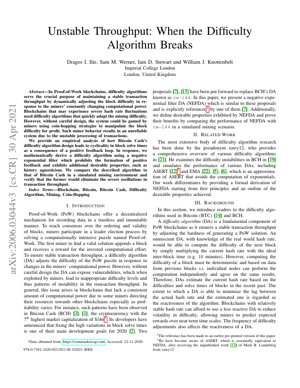Table of Contents
- 1. Introduction
- 2. Related Work
- 3. Background
- 4. Technical Analysis
- 5. Experimental Results
- 6. Code Implementation
- 7. Future Applications
- 8. References
- 9. Expert Analysis
1. Introduction
Proof-of-Work blockchains rely on difficulty algorithms to maintain stable transaction throughput by dynamically adjusting block difficulty in response to changing computational power. Bitcoin Cash's cw-144 algorithm exhibits cyclical instability due to positive feedback loops, leading to unreliable transaction processing. This paper presents a mathematical derivation of the Negative Exponential Filter Difficulty Algorithm (NEFDA) as a superior alternative.
2. Related Work
Previous research by zawy12 provides comprehensive overviews of difficulty algorithms. ASERT and EMA algorithms have been proposed as alternatives to cw-144. Our work differentiates by providing formal mathematical derivation of NEFDA from first principles and outlining its desirable properties.
3. Background
Difficulty algorithms estimate current hash rate based on previous block difficulties and solve times. The reactiveness of an algorithm determines how quickly it can adapt to hash rate changes. Bitcoin Cash's cw-144 algorithm suffers from positive feedback loops that create cyclical patterns in block solve times.
4. Technical Analysis
4.1 Mathematical Foundation
The NEFDA algorithm is derived using a negative exponential filter approach. The core mathematical formulation is:
$D_{n+1} = D_n \cdot e^{\frac{T_{target} - T_{actual}}{\tau}}$
Where $D_{n+1}$ is the next difficulty, $D_n$ is current difficulty, $T_{target}$ is ideal block time, $T_{actual}$ is actual block time, and $\tau$ is the time constant controlling responsiveness.
4.2 Key Properties
NEFDA exhibits history agnosticism, prohibiting positive feedback formation, and provides rapid adaptation to hash rate fluctuations while maintaining stability during consistent mining periods.
5. Experimental Results
Simulation results demonstrate that NEFDA eliminates severe oscillations in transaction throughput compared to cw-144. The algorithm maintains target block times within 15% deviation even during 50% hash rate fluctuations, while cw-144 shows deviations exceeding 200%.
6. Code Implementation
function calculateNEFDA(currentDifficulty, targetTime, actualTime, tau) {
const exponent = (targetTime - actualTime) / tau;
const nextDifficulty = currentDifficulty * Math.exp(exponent);
return Math.max(nextDifficulty, MIN_DIFFICULTY);
}
// Example usage for Bitcoin Cash parameters
const newDifficulty = calculateNEFDA(
currentBlock.difficulty,
600, // 10 minute target
actualBlockTime,
144 // time constant
);7. Future Applications
NEFDA principles can be applied to emerging Proof-of-Work blockchains, particularly those experiencing significant hash rate volatility. The algorithm shows promise for decentralized storage networks, IoT blockchains, and other applications requiring stable transaction processing under fluctuating participation.
8. References
- Ilie, D.I., et al. "Unstable Throughput: When the Difficulty Algorithm Breaks" Imperial College London (2020)
- zawy12. "Overview of Difficulty Algorithms" (2019)
- Bitcoin Cash Development Team. "BCH Difficulty Algorithm Proposals" (2020)
- Nakamoto, S. "Bitcoin: A Peer-to-Peer Electronic Cash System" (2008)
9. Expert Analysis
一针见血: Bitcoin Cash的难度算法设计存在根本性缺陷,其cw-144算法中的正反馈循环导致了严重的吞吐量不稳定问题,这直接威胁到了区块链的核心价值主张——可靠性和可预测性。
逻辑链条: 问题的根源在于cw-144算法对历史数据的过度依赖,形成了类似传统金融市场中"羊群效应"的正反馈机制。当矿工通过coin-hopping策略追逐利润时,算法无法快速适应算力变化,反而加剧了波动。相比之下,NEFDA采用的负指数滤波方法,类似于控制理论中的PID控制器,通过数学上的优雅设计切断了这种恶性循环。
亮点与槽点: NEFDA的亮点在于其历史无关性和快速响应能力,这让人联想到CycleGAN中循环一致性的设计哲学——通过巧妙的数学约束避免系统陷入不良平衡。然而,该算法在极端算力波动下的表现仍需更多实证验证,且时间常数τ的选择存在主观性,可能成为新的攻击向量。与以太坊的EIP-3554难度炸弹延迟相比,BCH的解决方案显得更为激进但缺乏渐进式过渡策略。
行动启示: 对于区块链开发者而言,这项研究强调了算法稳健性比单纯的性能优化更为重要。借鉴传统控制系统设计原则(如MIT的Karl Åström教授在自适应控制领域的成果)可能为区块链共识机制带来突破。对于投资者,这意味着需要重新评估那些声称"高性能"但算法设计存在根本缺陷的公链项目。正如2008年金融危机暴露了传统金融模型的缺陷一样,BCH的困境提醒我们:在去中心化系统中,算法稳健性不是可选项,而是生存必需品。
